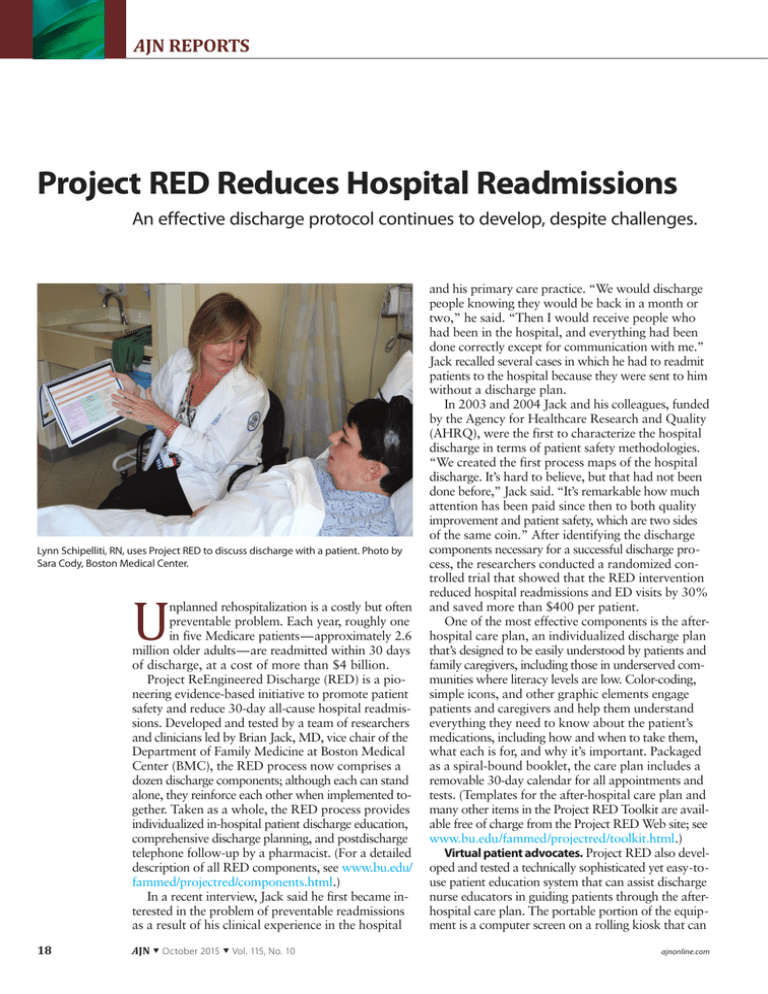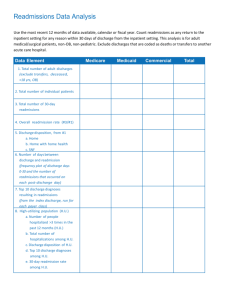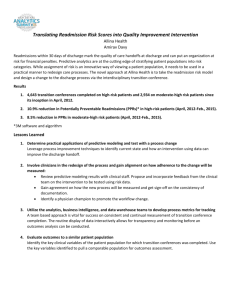Project RED Reduces Hospital Readmissions
advertisement

AJN REPORTS Project RED Reduces Hospital Readmissions An effective discharge protocol continues to develop, despite challenges. Lynn Schipelliti, RN, uses Project RED to discuss discharge with a patient. Photo by Sara Cody, Boston Medical Center. U nplanned rehospitalization is a costly but often preventable problem. Each year, roughly one in five Medicare patients—approximately 2.6 million older adults—are readmitted within 30 days of discharge, at a cost of more than $4 billion. Project ReEngineered Discharge (RED) is a pioneering evidence-based initiative to promote patient safety and reduce 30-day all-cause hospital readmissions. Developed and tested by a team of researchers and clinicians led by Brian Jack, MD, vice chair of the Department of Family Medicine at Boston Medical Center (BMC), the RED process now comprises a dozen discharge components; although each can stand alone, they reinforce each other when implemented together. Taken as a whole, the RED process provides individualized in-hospital patient discharge education, comprehensive discharge planning, and postdischarge telephone follow-up by a pharmacist. (For a detailed description of all RED components, see www.bu.edu/ fammed/projectred/components.html.) In a recent interview, Jack said he first became interested in the problem of preventable readmissions as a result of his clinical experience in the hospital 18 AJN ▼ October 2015 ▼ Vol. 115, No. 10 and his primary care practice. “We would discharge people knowing they would be back in a month or two,” he said. “Then I would receive people who had been in the hospital, and everything had been done correctly except for communication with me.” Jack recalled several cases in which he had to readmit patients to the hospital because they were sent to him without a discharge plan. In 2003 and 2004 Jack and his colleagues, funded by the Agency for Healthcare Research and Quality (AHRQ), were the first to characterize the hospital discharge in terms of patient safety methodologies. “We created the first process maps of the hospital discharge. It’s hard to believe, but that had not been done before,” Jack said. “It’s remarkable how much attention has been paid since then to both quality improvement and patient safety, which are two sides of the same coin.” After identifying the discharge components necessary for a successful discharge process, the researchers conducted a randomized controlled trial that showed that the RED intervention reduced hospital readmissions and ED visits by 30% and saved more than $400 per patient. One of the most effective components is the afterhospital care plan, an individualized discharge plan that’s designed to be easily understood by patients and family caregivers, including those in underserved communities where literacy levels are low. Color-coding, simple icons, and other graphic elements engage patients and caregivers and help them understand everything they need to know about the patient’s medications, including how and when to take them, what each is for, and why it’s important. Packaged as a spiral-bound booklet, the care plan includes a ­removable 30-day calendar for all appointments and tests. (Templates for the after-hospital care plan and many other items in the Project RED Toolkit are available free of charge from the Project RED Web site; see www.bu.edu/fammed/projectred/toolkit.html.) Virtual patient advocates. Project RED also developed and tested a technically sophisticated yet easy-touse patient education system that can assist discharge nurse educators in guiding patients through the afterhospital care plan. The portable portion of the equipment is a computer screen on a rolling kiosk that can ajnonline.com be brought to the patient’s bedside. Depending on the patient’s preference, one of two avatars—animated figures known as Louise and Elizabeth—appears on screen, and the patient interacts with the virtual advocate through a touch screen or with a mouse, answering questions and prompts about medications and appointments. At the end of a session, a nurse can print out what patients didn’t understand or answer correctly and review it with them. The system is not yet in general use at BMC. “Louise may still be ahead of her time,” Jack remarked, “but there’s no question that in the future, systems like Louise will be an important part of health education.” WHAT’S HOLDING BACK IMPLEMENTATION? Efforts to reduce hospital readmissions are increasing nationwide, but not as quickly and thoroughly as one might expect, given the demonstrated effectiveness of RED and other readmission reduction interventions. Jack contends that the biggest obstacle to wider implementation is financial. In fiscal year 2013, the Centers for Medicare and Medicaid Services initiated the Hospital Readmissions Reduction Program (HRRP), which penalizes hospitals that have higher than average readmission rates among patients with common but serious conditions, such as heart failure and pneumonia. Three years into the program, more diagnoses have been added and 78% of hospitals that are subject to the HRRP will receive reduced Medicare reimbursements; but in the majority of cases, those penalties will be less than 1% of the hospital’s total Medicare payment. “Hospital executives will say they want to know how to reduce rehospitalizations but don’t want to do it yet,” Jack said. “We’re still in a mixed-incentive environment. Most hospitals still bill on a fee-for-service basis. It’s all about heads on beds.” WHAT’S NEXT FOR RED? Jack is confident that the RED protocol offers a reliable and replicable prototype for hospital-based intervention, and he believes the next step is to strengthen and standardize the other side of this critical transition in care. “It has become very clear that the role of the primary or specialty care practice—that is, whoever receives the patient and provides care in the community—is very important in reducing readmission rates,” Jack said. “Hospitals have to learn to work not only with primary care practices, but also with end-of-life care providers, family caregivers, and others.” The Project RED team is also looking at diverse patient populations that present discharge challenges. Jack noted that patients with complex mental health ajn@wolterskluwer.com issues are among the most expensive to care for and that they are three times more likely than other patients to be readmitted to the hospital within 90 days. This has prompted the RED team to study interventions such as screening for and patient education on depression, and referrals to treatment. A NURSE’S PERSPECTIVE Among the nurses who have contributed to Project RED, the most experienced is Lynn Schipelliti, RN, who spent a decade working on the initiative. She describes RED as “a process that encompasses communication and facilitates care along the continuum, engaging patients in their own health care and providing them with confidence that they can effectively transition from the hospital back into the community.” She joined the research team in 2006 as discharge nurse educator and received special training in how to teach the content of the individualized after-hospital care plans to patients who received RED. ‘Teaching patients is the best way to improve their health. Patients who are well informed know how to stay out of the ED.’ “Sharing of information is vital to everything we do,” Schipelliti says. “And teaching patients is the best way to improve their health. Patients who are well informed are more likely to participate in their care, adhere to their medications, report adverse effects before they become serious, and know when to call their physician and how to stay out of the ED.” In 2008 Schipelliti began to take on other REDrelated projects, travelling with other team members to conduct trainings on RED implementation at hospitals in California, Texas, and Illinois. She was also involved in the development of the virtual discharge advocates, Louise and Elizabeth. Schipelliti now works as a clinical nurse liaison for BMC HealthNet, an insurance company that partners with the medical center, but she recalls her time with Project RED fondly. “For 10 years it was my lifeblood. I believe in Project RED. It was a wonderful part of my career.” (For more on Project RED, see “A Project to Reengineer Discharges Reduces 30-Day Readmission Rates: A Texas Hospital Achieves Improvement in its Readmission Rate by Implementing Project RED,” July 2013.)—James M. Stubenrauch ▼ AJN ▼ October 2015 ▼ Vol. 115, No. 10 19



